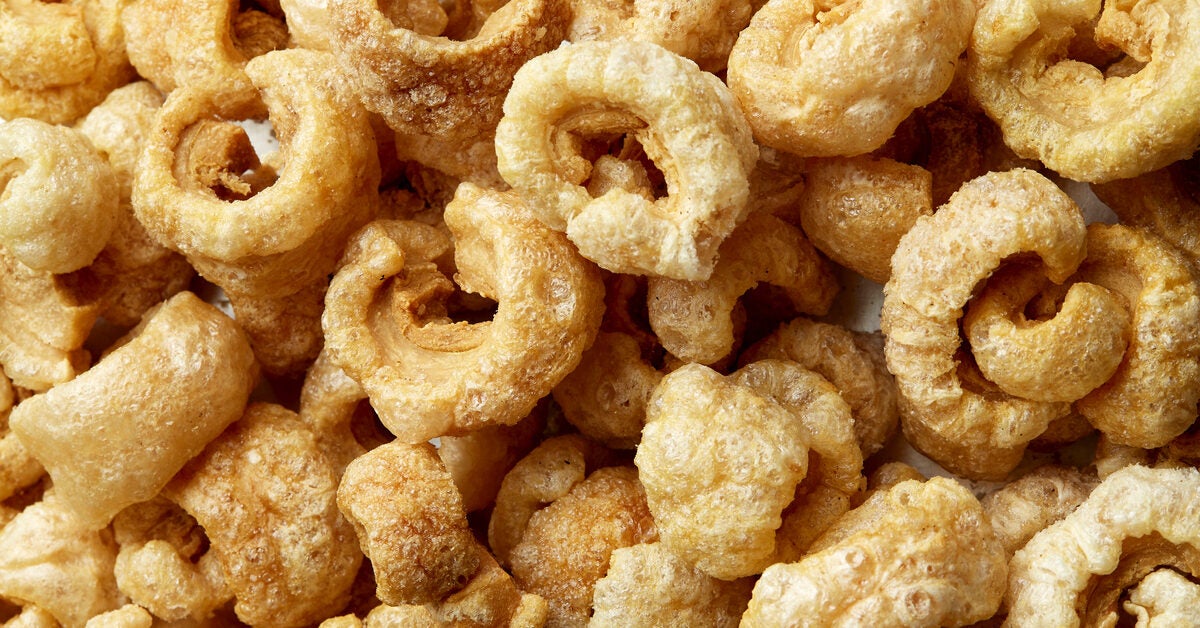The richest sources of collagen are skin, bone, joint material and certain organs. These can come from any fish, fowl, or land animal.
To combat your 1-2% loss of collagen every year, you need to eat foods high in collagen. It’s only found in four foods: bone broth, some organ meats, meat on the bone (which includes cartilage, skin, bone, and joint material), and eggs. These foods actually have collagen protein in them, which is different from foods like fruits and vegetables that claim to help your body make more collagen. You could also take a multi-collagen supplement, but it’s always better to eat foods that are high in collagen first.
In the past few years, pork rinds have become a popular snack, especially among people who follow keto or low-carb diets. Their crispy, salty crunch makes them hard to resist. But do these tasty treats contain collagen, the trendy protein that keeps skin and joints looking young? Let’s find out if pork rinds give you more collagen along with their tasty flavor.
What Are Pork Rinds?
If you deep-fry or roast pig skin until it puffs up and gets crispy, you have pork rinds. They are also called pork skins or chicharrones. When you cook pork rinds, the fat under the skin breaks down, leaving only the crunchy rind.
Pork rinds have long been enjoyed across many cultures as a portable protein-packed nibble. Their low carbohydrate high fat nutrition profile has recently thrust pork rinds into the limelight as a keto diet darling.
Collagen Basics
Collagen is the most abundant protein in the human body. It makes up the main structural component of connective tissues like skin, tendons, ligaments, cartilage, bone, and blood vessels
Collagen gives skin its youthful elasticity and strength. It also provides the cushioning, flexibility, and resilience needed for healthy joints and bones. Collagen levels decline with age, leading to common signs of aging like wrinkles, sagging skin, and joint discomfort.
Eating foods like pork rinds that are high in collagen can help keep collagen levels from dropping. When you eat, your body breaks down collagen into amino acids, which are then used to make more collagen.
Do Pork Rinds Contain Collagen?
Yes, pork rinds contain collagen! Here’s why:
-
Pork rinds are made from pig skin, which is naturally high in collagen. Skin contains large amounts of the fibrous structural proteins that make up collagen.
-
Collagen makes up 30% or more of the protein content in pork skin. It’s second only to muscle proteins like myosin and actin.
-
The collagen in pork skin is composed of Type 1 collagen, the most abundant type of collagen in the human body. Consuming Type 1 collagen provides direct support for body tissues.
-
Heating processes like frying and roasting do not destroy the collagen in pork rinds. These cooking methods actually help break collagen down into gelatin, which is beneficial for digestion.
So each crisp, salty bite of pork rind delivers a boost of age-defying collagen!
How Much Collagen is in Pork Rinds?
The exact collagen content of pork rinds can vary depending on factors like the size and quality of the pork skin. However, pork rinds are considered an excellent source of collagen.
A 1 ounce (28g) serving of pork rinds contains around:
- 5-8 grams of protein
- 2-5 grams of collagen
So in just a handful of pork rinds, you can get 11-28% of your protein intake from energizing collagen!
Compare that to the collagen content of other popular foods:
- Chicken skin: 1.5-5 g of collagen per 3 ounces
- Bone broth: 2-5 g collagen per cup
- Beef jerky: around 3 g collagen per ounce
As you can see, pork rinds provide an impressive collagen punch!
Health Benefits of Collagen in Pork Rinds
Eating collagen-containing foods like pork rinds offers several science-backed health perks:
-
Supports skin health: Collagen strengthens skin structure and elasticity. It helps reduce wrinkles and promote vibrant, youthful skin.
-
Eases joint pain: Collagen builds cushioning cartilage to improve joint mobility and reduce discomfort.
-
Strengthens nails & hair: Keratin-rich collagen nourishes nails and hair follicles for growth and resilience.
-
Aids digestion: Collagen can improve gut integrity and heal leaky gut syndrome. It also helps transport nutrients through the intestinal wall.
-
Protects heart health: Collagen provides structural support to artery walls and may reduce plaque buildup.
So by snacking on pork rinds, you can reap beauty, fitness, gut, and heart-protecting benefits!
Tips for Maximizing Collagen from Pork Rinds
Follow these simple tips to get the most out of collagen-containing pork rinds:
-
Look for quality: Choose reputable brands that use pasture-raised pork without unnecessary additives.
-
Enjoy in moderation: Limit portions to a 1 ounce serving per day to keep calories in check.
-
Pair with vitamin C: Eat pork rinds with vitamin C-rich foods like oranges, peppers, or broccoli to boost absorption.
-
Stay hydrated: Drink water with pork rinds to support collagen production and skin health.
-
Exercise: Pair regular exercise with collagen consumption to improve joint resilience.
Drawbacks of Relying on Pork Rinds for Collagen
While pork rinds do contain beneficial collagen, there are a few downsides to relying solely on them as your collagen source:
-
High in sodium: Pork rinds are very high in sodium, with over 500mg per serving. Too much sodium can lead to high blood pressure and water retention.
-
High in saturated fat: The type of fat in pork rinds may raise LDL cholesterol levels when eaten in excess.
-
Minimal vitamins & minerals: Pork rinds offer plenty of protein but lack other valuable nutrients found in whole foods.
-
Heavily processed: As a processed convenience snack, pork rinds lack the wholesomeness of collagen-rich homemade bone broths or stews.
For these reasons, it’s smart to enjoy pork rinds in moderation as part of an overall nutrient-dense diet, rather than relying on them as your sole collagen source.
Other Dietary Sources of Collagen
In addition to pork rinds, incorporating other naturally collagen-rich foods can give your body the building blocks it needs for youthful vitality:
- Bone broth & meat stocks
- Chicken skin
- Beef, pork, lamb & fish skin
- Eggshell membranes
- Wild-caught fish
- Turkey legs & wings
- Beef cheeks
- Chicken feet
- Beef liver
- Berries
Aim for a variety of whole food sources to take advantage of collagen’s diverse health benefits!
The Bottom Line
So do pork rinds contain collagen? Absolutely! As a skin-based snack, pork rinds provide a substantial amount of beneficial Type 1 collagen. Just one serving delivers a satisfying crunch along with compounds to support your complexion, joints, gut health, and more. Moderation is key, but the occasional pork rind can be part of a collagen-rich diet. Crunch and glow on!

Collagen College™ right to your inbox!
We release thorough, well-researched, and entertaining collagen info every month and can notify you via email.
Recently from Collagen College™
![]()
![]()
![]()
![]()
![]()
![]()
![]()
![]()
![]()

Founded in Orlando, Florida
Top 5 Foods High in Collagen!
Does pork rinds contain collagen?
Pork rinds contain some collagen since they include the skin. Cooked pork rinds are sometimes used as snacks and ingredients for people on low carb diets. However, the portion sizes mean that you’re probably not getting a large amount of collagen from pork rinds.
Is pork skin a good source of collagen?
Pork skin Pork skin is another popular source of collagen. One study showed that collagen supplements sourced from pig skin improved osteoarthritis symptoms and quality of life of people with arthritis of the knee. Pork skin is used to make pork rinds, a popular snack.
Are organ meats a good source of collagen?
Organ meats are a good source of collagen. They include options like liver and kidneys. You can also get collagen from less commonly used parts of the animal, including joint material, skin, and cartilage. Tripe is another option. Organ meats are rich in collagen and also contain other essential nutrients.
Does meat on the bone contain collagen?
Shawn Baker, M.D., author of The Carnivore Diet, stated in our MeatRx podcast interview that collagen only makes up about 3% of beef steak. So yes, meat on the bone does contain collagen, but there are plenty of other food sources that might be a better option if you’re looking for collagen-rich foods!
